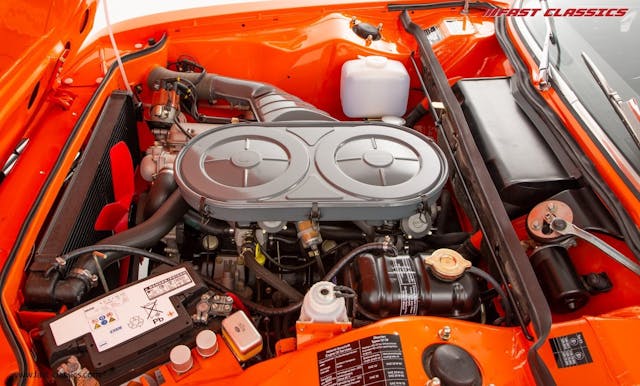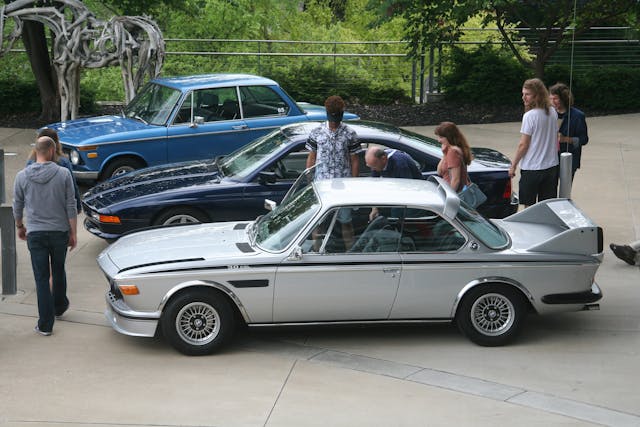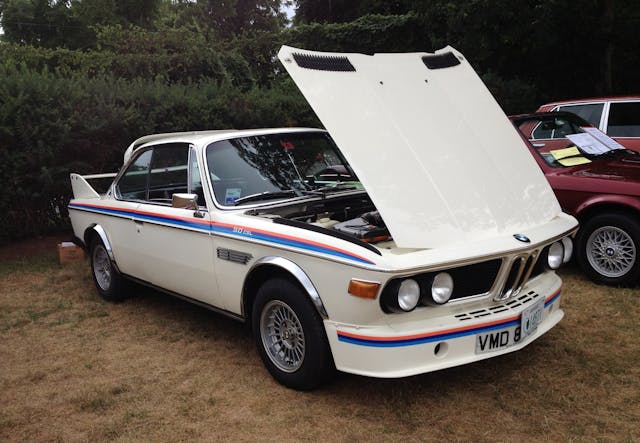Media | Articles
What, exactly, is a BMW 3.0CSL?

Like any good car nut, I have a framed iconic car poster in my garage. It shows Hans Stuck driving a BMW 3.0CSL at the Nürburgring in 1974. All four wheels are airborne. It’s an awesome shot—a glorious blur of fat tires, flared fenders, air dams, BMW Motorsport-colored livery, and side scoops. You can just feel the passion and the speed.
The 3.0CSL was one of those 1970s “homologation specials.” That is, the model was a version of the regular E9 coupe (the 2800 CS and 3.0CS/CSi) manufactured specifically so BMW could race it in the European Touring Car series. A thousand cars needed to be built and sold as street vehicles in order to pass muster with the Fédération Internationale de l’Automobile (FIA) and be raced.
Wait, so BMW built a thousand of the flying cars?
No. Not even close.
And the flying car is what they call a “Batmobile?”
Marketplace
Buy and sell classics with confidence
Well, sort of, but not really.
I’m going to straighten this out. It’s really pretty simple, and I’m astonished it’s not better-explained in the dozens of 3.0CSL articles I’ve read.

Here’s the deal. There were street CSL and racing CSLs. Most of the street CSLs look pretty much like the standard 3.0CS. Only the last 167 were “Batmobiles” with the cool aerodynamic package. The racing CSLs built by the factory, like the flying car in the photo, are different beasts entirely. Yes, some of them have the Batmobile’s wings, but they also have much more. I mean, they’re race cars. And authentic ones are far rarer than either the regular CSLs or the Batmobiles and are now worth an ungodly amount of money, so if you see one driving around, or at a show that isn’t at the level of Amelia Island—I mean The Amelia—odds are that it’s a tribute car as opposed to the real thing.
There. That wasn’t so hard, was it?
Here are the details.
Let me start by saying that I’m not a motorsport guy. I’m really not terribly interested in the racing history of any car, even this one. You can read about it elsewhere. However, the 3.0CSL was a seminal vehicle for BMW, as even though it wasn’t badged as an “M” car, it was the car that birthed BMW’s Motorsport division, which then went on to build—and race—some of the company’s most iconic vehicles, such as the E30 M3. The 3.0CSL is also the first BMW to carry the famous red-blue-violet colors. We’ll get back to that when I talk about the race cars.
The Street Cars
The “L” in CSL stands for “leichtbau” (light construction). To make a homologation car out of the E9, Alpina took a 3.0CS and lightened it for BMW (yes, Alpina built the first prototype CSL). Then it incorporated lighter bolt-on items and eliminated others. An aluminum hood, trunk lid, and door skins and a plastic rear bumper were fitted on a body shell built with thinner metal. Perspex (plastic) was substituted for the glass rear windshield and rear side windows (it’s actually Lexan, but most folks refer to it as Perspex), and a thinner front windshield, thinner carpets, and light Scheel racing seats were used. Hand-crank windows replaced the electric ones in the front, and the rear side windows became fixed. The front bumper, the hood torsion spring and release latch mechanism, the power steering, sound insulation, undercoating, and the trunk-mounted tool kit were deleted. Even the trunk lock was removed. Collectively, this saved about 440 pounds on CSLs that had all these “comfort” items removed. In addition to the missing front bumper, the car’s obvious visual identifying cues were the distinctive stripes with the text “3.0CSL” over the fender, the chrome fender lips to accommodate the wider 14×7 finned Alpina wheels, and the Cobra-style hood pins. Interior-wise, if the car lost some amenities, its elegant vibe was maintained by the striking combination of the E9’s standard wood dashboard, the Scheel seats, the distinctive CSL-specific Petri three-spoke steering wheel with its holes of decreasing radii on the spokes, and a black headliner.
And yes, since Karmann manufactured the CSL’s bodies as they did the regular E9, all this lightening means that they took an E9 coupe, which is a legendary rust bucket, and made it even more rust-prone.

From there, it starts to get complicated, as you can slice the street-going CSL pie by engine size, by induction (carbureted or injected), by left or right-hand drive, by level of amenities, and by aerodynamics. It makes the most sense if you step through it sequentially.
BMW liked Alpina’s prototype and began producing them. The first batch of 169 CSLs began rolling out in late 1971. They were all left-hand drive, powered by the same 2985-cc, 180-horsepower, carbureted, in-line, six-cylinder, 12-valve M30 engine that the standard 3.0CS had, fed by the same pair of down-draft progressive Zeniths. These early CSLs are sometimes referred to as pre-production prototypes, though how much of that is marketing pablum from folks trying to sell them is unclear. I mean, 169 is a fair number of “prototypes.” I’ve also seen them referred to as “ultra-lightweights,” as very, very few of the later cars had the Perspex rear windows when new. I’m told that most CSL aficionados just call them “carb cars.”

The next batch comprising the bulk of the thousand cars required for homologation began in September 1972. A total of 429 left-hand-drive cars and 500 right-hand-drive cars were built. The engine size was increased slightly to 3003 cc to allow the cars to race in the over-three-liter category. The induction system was changed from carburetors to Bosch D-Jetronic, the early electronic injection system that was being used in the non-lightweight 3.0CSi. Horsepower was increased to 200. To distinguish them from the earlier carbureted CSL, the injected cars are sometimes referred to in the literature as the CSiL, though the badge on the back still says “3.0CSL.”

Within the Series 2 cars, there’s the issue of the so-called “Stadtpacket” or “city package,” also sometimes referred to as the “town package.” This was a BMW option package specified for all of the RHD cars brought into Great Britain by the importer. The idea was that some customers might not be thrilled with spending all that money for something fragile and Spartan, so the package restored many of the things that were done to lighten the car. Most but not all of the city package cars had the standard non-CSL steel trunk lid and door skins. Metal front and rear bumpers were put back on, as was power steering, power windows, thick carpets, sound insulation, undercoating, an interior hood release instead of the hood pins, the tool kit on the underside of the trunk lid, and a trunk lock. This cut the weight savings down from 440 pounds to closer to 250. Most articles talk about the city package as only applying to the 500 RHD cars, but one of the foremost CSL collectors in the country tells me that a majority of the 429 LHD cars were either city package cars or had some of the comfort items installed when new, and that as few as 20 of the Series 2 cars were full lightweights like the Series 1 cars.
A small number of LHD cars were ordered with the city package as well. The external tip-offs to the city package’s L-ness were reduced to the CSL stripes, the chrome fender arch trim, the Alpina wheels, and the Scheel seats. And, of course, the badge on the trunk.
When I saw car in the photo below at the Vintage last spring in Asheville, North Carolina, it had me fooled. The black CSL stripes and chrome fender lips had been removed for an inexpensive repaint. It wasn’t until I stuck my head inside, saw the right-hand drive configuration, the Scheel seats, and the black headliner, that I blurted out “OMG, this is a city-package CSL!” Turns out the tandem bike on the roof wasn’t just for show. The owner runs a bicycle business. He said he loves driving the car—he drove it down from Indiana—but felt bad that he didn’t have the money to restore it. “Don’t you dare,” I said, “make any apologies about this car because someone else thinks you need to spend $150K that you don’t have to turn it into what they think it should be. It’s massively cool just the way it is. It’s the coolest E9 here. It’s probably the coolest BMW here, period.” I think I made his day.

Next and smallest in number were the famous “Batmobiles,” the cars that many people think of when you say “3.0CSL.” These are the ones with the iconic massive trunk wing, the “hoop” spoiler at the top of the rear windshield, and the front fender windsplits. The oft-told story is that the trunk wing was so big that it contravened German road laws, so if the car was being sold in Germany or shipped to another country where it was illegal, the wing was shipped in the trunk, and the dealer or owner had to install it. Further, the wing was large enough that the downforce generated proved to be problematic for the lightweight aluminum trunk lid, so Batmobile’s have steel trunk lids.

All Batmobiles were left-hand drive and had an injected engine whose displacement was increased to 3.2 liters (3153 cc, 206 hp). Two small batches were built. They’re sometimes referred to as Series 1 and Series 2 Batmobiles, which of course is instantly confusing with the Series 1 and 2 nomenclature that’s applied to all CSLs. The first batch—110 cars—was produced 7/73 through 10/73, with the cars available only in Polaris (silver) and Chamonix (white). The second batch of 57 cars, produced from 1/74 to 10/75, were available in all of the BMW factory colors, and reportedly could be ordered with a la carte options such as electric rear windows and air conditioning. In addition, most of the final-batch Batmobiles had a third supporting fin in the center of the trunk wing. So, if you see a winged CSL in a zingy color like Golf (yellow) or Taiga (metallic green), you can act smart and say, “If that’s original, it must be a Series 2 Batmobile.”

I’m uncertain when the thin, red-blue-violet Motorsport-colored side stripes crept in. I don’t believe I’ve seen them on non-Batmobile CSLs. Since I’ve seen both Batmobile batches with both black and Motorsport stripes, I assume they were an option.

These three sets of cars—the 169 carbureted LHD, 2985-cc first series, the 929 injected LHD and RHD 3003-cc second series (most of the RHD cars having the city package), and the 167 3.2-liter injected Batmobiles (first and second batch)—comprise the CSL road cars. They’re all real CSLs.
Now, having laid out the CSL road car taxonomy, don’t take any of what I say as canon. Bring a Trailer auctions are full of comments from folks with enough knowledge to be dangerous, saying things like, “Your city package car shouldn’t have aluminum panels” or “Your second-batch Batmobile should have a third vertical fin on the wing,” only to have the real experts point out that the cars were all low-production and hand-built, and not every parts change fell along published boundaries.
For all the CSL’s hype, the cars are mechanically very similar to the stock 3.0CS and CSi. Other than being equipped with shorter springs and gas-pressure Bilsteins when new, and having increased front and rear negative camber specifications, there’s not much difference.
As with many classic cars, there’s a certain degree of trim augmentation that’s gone on. It’s not unusual to see standard non-lightweight E9s (2800CS, 3.0CS/CSi) wearing CSL chrome fender trim. And reproductions of the Batmobile aerodynamic package have made it easy for both heavyweight and lightweight E9s to sport the spoilers and run around as Batmobiles. Personally, I see nothing wrong with “tribute cars” so long as, when asked, you say “it’s a regular 3.0CS but I bolted on the chrome fender lips and the Batmobile stuff.” Of course, with rising CSL values, it’s now swinging the other way—the importance of originality catches up with the desire for bling, and Bring a Trailer listings sometimes detail the removal of a non-original Batmobile package on a correctly-restored first or second-series CSL.
The Race Cars
The race cars are a whole different subject. They’re, well, race cars. The interiors are gutted. The wood dash is gone. There’s a roll cage, a fire extinguisher, and a ton of buttons. And there’s livery (paint and graphics of the sponsor). Lots and lots of livery. This is important, because it dramatically affects what you’re seeing when you see the cars.
My understanding is that there were 21 factory race cars built to participate in FIA European Touring Car Group 2, Group 4, and Group 5 action. (There were also street CSLs that were turned into race cars by privateers, but that’s another story.) The Group 2 cars such as the one in the famous poster above originally had a massaged version of the standard 12-valve M30 engine, and fender flares to accommodate the wider race rubber. As you move from Group 2 to 4 to 5, the engine, fender flares, brake ducts, and front air dam all become more outrageous.
The “flying car” in the poster was black with Motorsport stripes, but most of BMW’s CSL race cars were white. The photo below shows a white Group 2 racing CSL. You can see what appear to be the stock Batmobile trunk and roof air dams, as well as moderate-sized fender flares. But the Motorsport-colored stripes are much more than just the thin side strips on the street CSLs. Instead, they completely dominate the look of the white cars. To many, this, not the street Batmobile, is what comes to mind when they imagine a 3.0CSL.

The Group 2 cars, however, look tame compared with the Group 4 and Group 5 cars with their massive, boxed fender flares and brake ducts. I’m rapidly wandering out of my depth here, but I believe that the Group 4 and 5 cars used the ultra-rare 24-valve 3.5-liter BMW M49 race engine outfitted with Kugelfischer mechanical injection and individual throttle bodies. At times, these 3.5CSLs literally breathed (well, spat) fire out the side-mounted exhausts. Visually, the two groups can be differentiated by the rear wing and the front air dam. The Group 4 cars are wearing the Batmobile trunk wing, but the wings and dams on the Group 5 cars extend further in front and in back.



With the Group 2, 4, and 5 race cars shown, we now have the basis to look at the famed art cars, since, to many non-car people, those are what come to mind when you say “BMW 3.0CSL.” By comparing the pics, you can see that the colorful Calder art car (which I also have a poster of in my garage) has Group 4 bodywork, as it has big fender flares with deep brake ducts, but the front air dam is modest, and the rear air dam looks like that on the Batmobile.

In contrast, you can see that the graph-paper-like Stella art car’s bodywork, with its snowplow-like front air dam and pushing-a-pram rear wing, is Group 5.

With that tutorial complete, I’ll leave you with this. What is it?


This photo shows the power of that Motorsport livery on white paint—it draws the eye away from the details. Your right brain says “race car,” but do you see fender flares? Do you see brake ducts? Do you see outrageous aerodynamics? No. This is a 3.0CS turned into CSL race car tribute, with a CSL front air dam, Batmobile roof hoop, the rear bumper taken off, and a clever wrap with the Motorsport livery printed on it. Pretty cool.
So, which one is a CSL? All of them (well, more correctly, all of them with original lightweight bodies). Which one is the iconic CSL? That’s up to you. As far as teaching the larger automotive world, learning to say “3.0CSL street car” and “CSL race car” is half the battle. It may be overly pedantic to insert “3.0CSL street Batmobile” between them, but if everyone did it, it would clear up a lot of confusion.
I’ll leave you with one final tidbit: You know the flying car—Hans Stuck on the Nürburgring—and the Calder art car? Do you know what they have in common (in addition to my having posters of them in my garage)?
They’re the same car. VIN 2275992. Now that’s passion.
***
Rob Siegel’s latest book, The Best of the Hack MechanicTM: 35 years of hacks, kluges, and assorted automotive mayhem, is available on Amazon. His other seven books are available here, or you can order personally inscribed copies through his website, www.robsiegel.com.
























Rob, That was an incredibly educational and entertaining dissertation on the 3.0CSL. Just wanted to thank you.